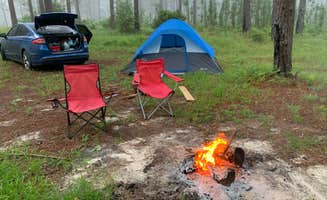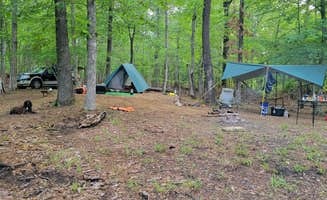Tent camping in Anacoco, Louisiana provides access to the diverse ecosystems of Kisatchie National Forest. Located in western Louisiana where pine forests dominate the landscape, this region typically experiences hot, humid summers with temperatures regularly exceeding 90°F and mild winters with occasional freezing temperatures. Primitive camping spots require careful planning as cell service is limited throughout much of the forest, particularly at sites like Coyote Camp where only spotty coverage exists.
What to do
Trail exploration: Access multiple hiking options from Coyote Camp where the Sandstone Trail system provides miles of recreational opportunities. As reviewer Fabein D. notes, the camp offers "direct access to the overlook and the sandstone trail," making it an excellent basecamp for day hikes.
Swimming: Cool off in forest waterways at Kisatchie Bayou NF Campground when water levels permit. "If its warm enough, you can swim!" reports Kayli M., highlighting one of the few swimming options in the region during summer months.
Night sky viewing: Experience minimal light pollution in the deeper sections of the forest. Fabein D. describes Coyote Camp as having "extremely quiet, great dark sky opportunities," making it ideal for stargazing during clear nights when the moon is new or crescent.
What campers like
Wildlife viewing: Observe native species around Red Bluff Camp, where the remote setting attracts diverse wildlife. Paula W. confirms: "Lots of wildlife in these trees," making it worthwhile to bring binoculars for spotting birds and mammals.
Creek sounds: Enjoy natural white noise that enhances the camping experience. Alex F. describes camping at Kisatchie Bayou: "Camp next to this beautiful sounding creek, there is a beach to lay out on while the kids play in the water," providing both visual and auditory natural experiences.
Solitude: Find weekday seclusion at Hunter's Camp in the Calcasieu District. One camper reported, "My wife and I camped here just before memorial day and had the entire campsite to ourselves," highlighting the often-overlooked advantage of non-peak camping times.
What you should know
Road conditions: Prepare for variable access routes to Coyote Camp and other sites. One reviewer noted, "Our GPS put us on a dirt road for a few miles - however it was well maintained and not too rutted," while others report more challenging driving conditions, particularly after rain.
Insect preparedness: Bring appropriate repellents as the forest ecosystem supports abundant insect life. Danny H. warns about Hunter's Camp: "Because of its location so deep in the woods mosquitoes, horseflies, and yellow flies were in abundance. Using a therma cell was perfect at keeping them at bay."
Water planning: Bring all necessary drinking water to Valentine Lake South Shore and most forest sites. Keith R. explains: "There is no power or water at sites but has community water faucets in a few areas," indicating that water sources are limited and sometimes distant from actual campsites.
Tips for camping with families
Beach areas: Locate waterfront sites for natural entertainment options. At Valentine Lake, a reviewer notes the "Great water front sites at $10 a night," providing both value and recreation options for children.
Wildlife awareness: Teach children about potential encounters with local fauna. One camper at Coyote Camp cautions: "We have seen a lot of snakes and it rains a lot. Some bees but not a serious nuisance. So just be aware when walking on the trails. Lots of deer and bobcats."
Activity planning: Balance outdoor time with Stuart Lake Recreation Complex options. Paula W. describes: "Within the Stuart Lake Recreation Complex there are lots of activities including fishing, swimming, hiking, and picnicking. Located on a 5-acre lake in a pine forest," offering family-friendly alternatives during hot afternoons.
Tips from RVers
Site selection: Scout potential spots in advance if possible. At Coyote Camp, Rod F. reports: "We found at least three sites that could accommodate our 26' class C," but notes this requires careful navigation of forest roads.
Resource management: Plan for primitive conditions as most sites lack hookups. "No water, must pack it in," explains Paula W. about camping in the Kisatchie National Forest, emphasizing the importance of water conservation strategies for longer stays.
Connectivity considerations: Check cell service availability for work needs. "Two to three bars of Verizon 4g, fast service," reports Rod F. about Coyote Camp, one of the few locations with reliable service in the forest.



